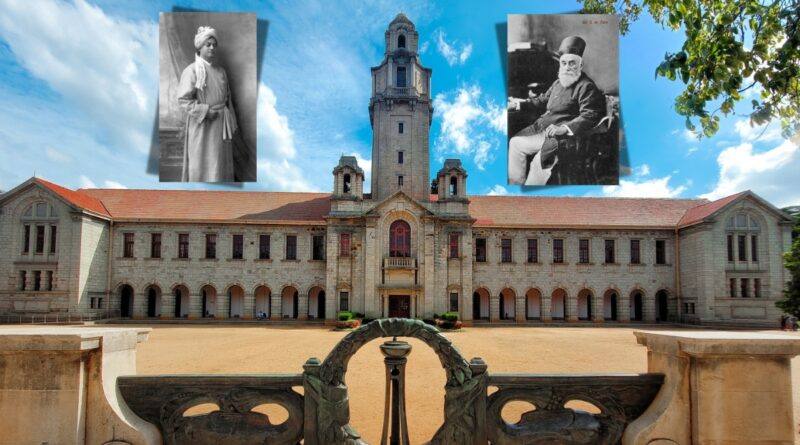See How Tata’s Amazing Journey With Swami Results In IISc
The transformative journey of Swami Vivekananda played a pivotal role in shaping Jamshetji Tata’s groundbreaking vision for the Indian Institute of Science (IISc). This remarkable connection between two iconic figures highlights the profound impact of spiritual and intellectual exploration on the pursuit of scientific advancement in India.
In the year 1893, a remarkable journey embarked, destined for the shores of the USA. The emerging nation was on the brink of hosting a groundbreaking event: the inaugural Parliament of Religions, a momentous occasion that promised to unite diverse faiths and foster dialogue among them. On board was Swami Vivekananda, a beacon of India’s philosophical wisdom, embarking on a journey to enlighten the materialistic West.
Joining him on this remarkable journey was none other than Jamsetji Tata, one of India’s pioneering industrialists and the visionary founder of the Indian Institute of Science (IISc) in Bengaluru. March 3 marks the celebration of his birth anniversary, honouring his lasting legacy.
The journey from Japan to the USA spanned more than 30 days, providing Jamsetji Tata and Swami Vivekananda with a unique opportunity to delve into profound conversations.
Their meeting transcended the typical journey, evolving into a rich dialogue that would ultimately shape the foundation of IISc in significant ways.

Swami Vivekananda and Narasimhacharya in the USA (Image: Wikimedia Commons)
Exploring the Legacy of Sir Jamsetji Nusserwanji Tata
In the serene town of Navsari, Gujarat, a remarkable figure emerged in 1839—Jamsetji Nusserwanji Tata. His legacy has since become a source of immense pride for India.
As the founder of the iconic Tata Group, he embarked on a remarkable journey that started with a textile mill in central India in 1870. His visionary approach also laid the groundwork for technical education in the nation, shaping the future of countless individuals.
From modest origins, his journey as a trailblazing industrialist began at the tender age of 14 when he stepped into his father’s business. Later on, he took the significant step of enrolling at Elphinstone College, where he distinguished himself as a Green Scholar, ultimately graduating in 1858.
Driven by an unwavering passion for business and a profound commitment to excellence, he embarked on a journey to revolutionise India’s industrial landscape.
What unfolded next marked the inception of a legacy that would ultimately crown him as one of India’s most revered philanthropists.

In the formative years of his illustrious career, Jamsetji N Tata laid the groundwork for what would become a legacy of innovation and philanthropy. His vision and determination set the stage for the Tata Trust, an institution that continues to impact lives and communities across India.
A correspondence with Swami Vivekananda
In 1893, a transformative journey from Japan to Chicago alongside the esteemed Swami Vivekananda left an indelible mark on Jamsetji Tata’s vision. During this pivotal moment, Swamiji was poised to unveil the rich tapestry of Indian spiritualism to the Western world.
Years following their remarkable journey, Jamsetji penned heartfelt letters to Swamiji, conveying his deep appreciation for the motivation and vision that had profoundly influenced him.
In the insightful work by Mukul Kanitkar and Anoop AJ, titled Essential Vivekananda, a notable letter captures the essence of the subject:
Dear Swami Vivekananda, I’m sure you recall our shared journey from Japan to Chicago, where we crossed paths as fellow travellers. Your insights on the evolution of the ascetic spirit in India remain etched in my memory. The emphasis was not on its destruction, but rather on guiding it towards more constructive avenues.
“The vision of establishing the Research Institute of Science for India lingers in my mind, a concept you may have encountered in discussions or writings.”
The correspondence underscored the profound dialogues shared by these two intellectual giants, illuminating the significance of both the natural sciences and the humanistic disciplines.
Jamsetji eloquently expressed his belief that the ascetic spirit could be harnessed in a profound way. He envisioned the creation of monasteries or residential halls, spaces where individuals embodying this spirit could reside in a manner of ordinary decency. Within these walls, he imagined them dedicating their lives to the pursuit and cultivation of science, fostering an environment ripe for intellectual growth and exploration.
The correspondence reveals the significant influence Swami Vivekananda had on Jamsetji’s aspirations for the scientific and educational progress of India.
The founding of IISC Bangalore
Jamsetji Tata’s visionary inspiration led to the establishment of the Indian Institute of Science (IISc) in 1909, a remarkable collaboration between the Indian government and the King of Mysore.
In his correspondence, Jamsetji expressed his aspiration for Swamiji to lead the initiative. With great enthusiasm, Vivekananda threw his support behind the project, leading to a committee spearheaded by Tata that presented the draft proposal to Viceroy George Curzon on December 31, 1898.

Tata Group, a name synonymous with innovation and excellence, continues to make waves across various industries. With a rich legacy that spans over a century, this conglomerate has established itself as a leader in sectors ranging from steel and automobiles to information technology and consumer goods. The group’s commitment to sustainability and social responsibility sets it apart, making it a beacon of corporate ethics in today’s fast-paced world. As Tata Group forges ahead, it remains dedicated to its core values while embracing new challenges and opportunities, ensuring its place at the forefront of global business. Stay tuned as we explore the latest developments and initiatives from this iconic institution.
Jamsetji expressed his belief that a well-led crusade advocating for this form of asceticism could significantly benefit not only the practice itself but also the realms of science and the esteemed reputation of our shared nation. It is hard to imagine a more suitable leader for such a campaign than Vivekananda. Would you be inclined to dedicate yourself to the mission of bringing our ancient traditions to life in this regard? Consider starting with a passionate pamphlet that ignites enthusiasm among our community regarding this issue. “I would gladly cover all the costs associated with publication.”
What started as a straightforward expedition across the vast Pacific Ocean evolved into a groundbreaking intellectual exchange, leaving an indelible mark on the future of Indian science and education.
The expedition transcended mere travel, sparking profound ideas that ultimately played a pivotal role in the founding of IISc.

Behold the iconic statue of Jamsetji Tata, proudly standing at the Indian Institute of Science, accompanied by a glimpse of the campus below. (Wikimedia Commons)

March 3 marks a significant occasion at IISc, celebrated with great pride as Founder’s Day. The Indian Institute of Science boasts a library that honours the legacy of JRD Tata, the son of the esteemed Jamsetji Tata, proudly bearing his name.
The library, originally established with funding from the University Grants Commission (UGC), made a significant transition to its current location in January 1965, coinciding with the grand celebrations of IISc’s golden jubilee. In a significant move in 1995, the name was changed to pay tribute to the esteemed JRD Tata.
In its formative years, the institute embarked on fundamental research in the realms of physics, chemistry, and electrical engineering, playing a pivotal role in advancing India’s scientific landscape.
Today, this institution stands as a beacon of innovation, celebrated for its exceptional contributions to interdisciplinary research. With a focus on advanced technology, it has made significant strides in fields such as space science, biotechnology, and artificial intelligence, solidifying its reputation as a world-class research hub.


The convergence of two intellectual titans, Swami Vivekananda and Jamsetji Tata, sparked a remarkable dialogue that seamlessly intertwined spirituality with the realms of industrial and scientific advancement. Swami Vivekananda’s vision of nation-building, rooted in education and self-reliance, profoundly influenced Tata as he diligently worked to establish the groundwork for India’s industrialised future.




